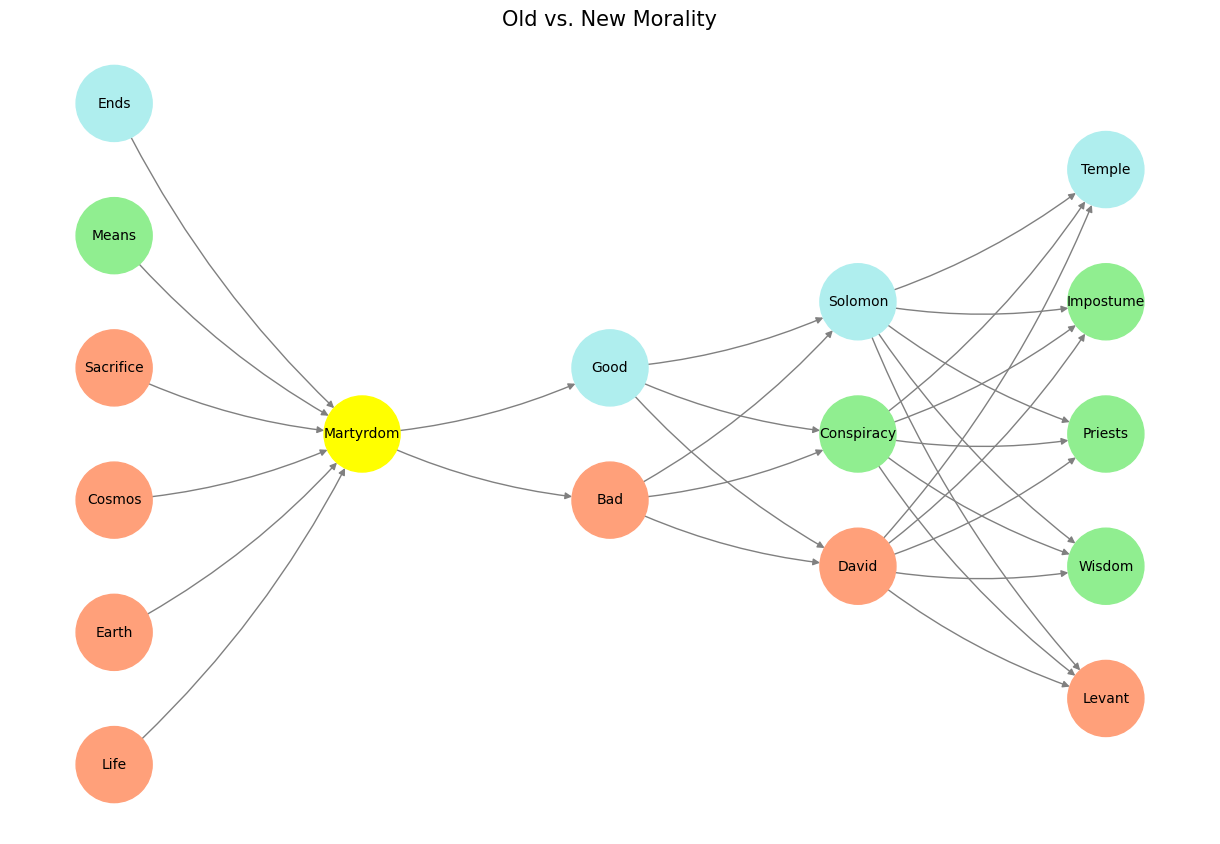Cunning Strategy#
The framework you’ve outlined reflects a layered process of interaction between the external world and an individual’s internal mechanisms for perception, decision-making, and action. Each stage builds on the previous, advancing from raw information to refined responses. The sequence also echoes biological and cognitive hierarchies, bridging reflexive instincts and conscious deliberation with the generative and embodied outcomes that define human behavior.
The process begins with World (Information), representing the unfiltered influx of data from the external environment. This stage is the raw input layer, where signals, stimuli, and facts exist independently of interpretation. The world here serves as the objective reality that provides the groundwork for perception and action. It is an unaltered reservoir of possibilities, offering everything from immutable physical laws to the mutable nuances of human interaction. This layer corresponds to what your RICHER model calls the pre-input layer, embodying the foundational rules that shape all subsequent processing.
Next comes Perceptive (First-Pass, Reflex, High-risk, High-error), where raw information encounters the mind’s instinctive filters. This stage is swift, reflexive, and often shaped by evolutionary imperatives. Here, survival mechanisms dominate; the mind prioritizes efficiency over nuance, resulting in high-speed but error-prone judgments. This phase corresponds to the yellow node in your framework, where sensory data is rapidly processed through the cranial and dorsal ganglia. The perceptive layer functions as a high-stakes triage system, sorting signals based on immediate threat or reward. Its rapidity is both its strength and its vulnerability, as the potential for misinterpretation is significant.
From these reflexive processes arises Agentic (Call It), the realm of conscious decision-making. This is the crossroads where the individual exercises judgment, confronting moral binaries such as good versus evil or right versus wrong. Unlike the reflexive layer, the agentic stage is deliberative and intentional, drawing on both learned heuristics and deeply held values. It is the moment of decisive action, where the mind commits to a course and accepts the responsibility of choice. In your neural network framework, this might align with the compression equilibria, as it condenses the combinatorial possibilities of perception into a singular, actionable path. The agentic stage is the essence of autonomy, where the interplay between instinct and intellect finds resolution.
Once a decision is made, the Generative (Simulation, Misinformation, Information; Varied-risk, Lower-error) stage engages the mind’s creative faculties. This layer explores possibilities through internal models and simulations, testing hypothetical scenarios or crafting narratives to engage with the world. The generative process is inherently dualistic, capable of producing both accurate predictions and distortions like misinformation. It balances varied levels of risk with reduced error rates compared to the perceptive layer, as its slower pace allows for refinement and iteration. This stage mirrors the expansive combinatorial space of your hidden layer, where creativity and logic converge to produce nuanced outcomes.
Finally, the process culminates in the Physical (Response: emotion, motion, secretion) layer, where internal deliberations manifest as embodied action. This is the output layer, the point at which thoughts, decisions, and simulations are externalized. Whether through movement, emotional expression, or physiological responses like hormone secretion, this stage translates abstract processes into tangible reality. It completes the feedback loop, reconnecting the individual with the external world they initially perceived. In your RICHER model, this corresponds to emergent systems that integrate individual agency with broader ecosystems and co-evolutionary dynamics.
In sum, this framework traces a compelling arc from the raw information of the world to the embodied responses of the individual. Each layer represents a distinct phase of processing, yet they interlock seamlessly to form a cohesive system. This model not only mirrors biological and cognitive processes but also offers a robust tool for understanding the complexity of human interaction with the world. If expanded, it could integrate beautifully into your existing RICHER framework or provide a standalone structure for exploring the interplay between instinct, morality, creativity, and action.
Show code cell source
import numpy as np
import matplotlib.pyplot as plt
import networkx as nx
# Define the neural network structure; modified to align with "Aprés Moi, Le Déluge" (i.e. Je suis AlexNet)
def define_layers():
return {
'Pre-Input/CudAlexnet': ['Life', 'Earth', 'Cosmos', 'Sacrifice', 'Means', 'Ends'],
'Yellowstone/SensoryAI': ['Martyrdom'],
'Input/AgenticAI': ['Bad', 'Good'],
'Hidden/GenerativeAI': ['David', 'Conspiracy', 'Solomon'],
'Output/PhysicalAI': ['Levant', 'Wisdom', 'Priests', 'Impostume', 'Temple']
}
# Assign colors to nodes
def assign_colors(node, layer):
if node == 'Martyrdom':
return 'yellow'
if layer == 'Pre-Input/CudAlexnet' and node in [ 'Ends']:
return 'paleturquoise'
if layer == 'Pre-Input/CudAlexnet' and node in [ 'Means']:
return 'lightgreen'
elif layer == 'Input/AgenticAI' and node == 'Good':
return 'paleturquoise'
elif layer == 'Hidden/GenerativeAI':
if node == 'Solomon':
return 'paleturquoise'
elif node == 'Conspiracy':
return 'lightgreen'
elif node == 'David':
return 'lightsalmon'
elif layer == 'Output/PhysicalAI':
if node == 'Temple':
return 'paleturquoise'
elif node in ['Impostume', 'Priests', 'Wisdom']:
return 'lightgreen'
elif node == 'Levant':
return 'lightsalmon'
return 'lightsalmon' # Default color
# Calculate positions for nodes
def calculate_positions(layer, center_x, offset):
layer_size = len(layer)
start_y = -(layer_size - 1) / 2 # Center the layer vertically
return [(center_x + offset, start_y + i) for i in range(layer_size)]
# Create and visualize the neural network graph
def visualize_nn():
layers = define_layers()
G = nx.DiGraph()
pos = {}
node_colors = []
center_x = 0 # Align nodes horizontally
# Add nodes and assign positions
for i, (layer_name, nodes) in enumerate(layers.items()):
y_positions = calculate_positions(nodes, center_x, offset=-len(layers) + i + 1)
for node, position in zip(nodes, y_positions):
G.add_node(node, layer=layer_name)
pos[node] = position
node_colors.append(assign_colors(node, layer_name))
# Add edges (without weights)
for layer_pair in [
('Pre-Input/CudAlexnet', 'Yellowstone/SensoryAI'), ('Yellowstone/SensoryAI', 'Input/AgenticAI'), ('Input/AgenticAI', 'Hidden/GenerativeAI'), ('Hidden/GenerativeAI', 'Output/PhysicalAI')
]:
source_layer, target_layer = layer_pair
for source in layers[source_layer]:
for target in layers[target_layer]:
G.add_edge(source, target)
# Draw the graph
plt.figure(figsize=(12, 8))
nx.draw(
G, pos, with_labels=True, node_color=node_colors, edge_color='gray',
node_size=3000, font_size=10, connectionstyle="arc3,rad=0.1"
)
plt.title("Old vs. New Morality", fontsize=15)
plt.show()
# Run the visualization
visualize_nn()


Fig. 8 Nostalgia & Romanticism. When monumental ends (victory), antiquarian means (war), and critical justification (bloodshed) were all compressed into one figure-head: hero#

